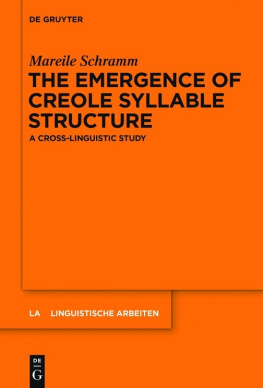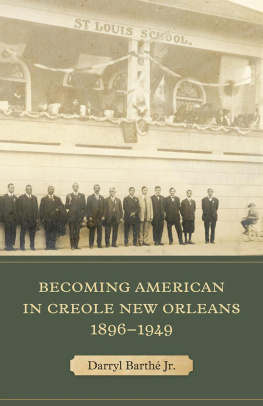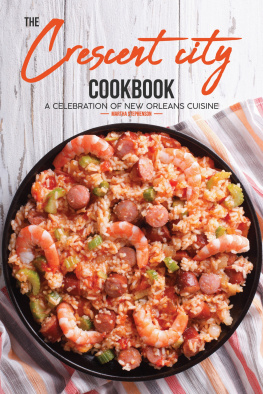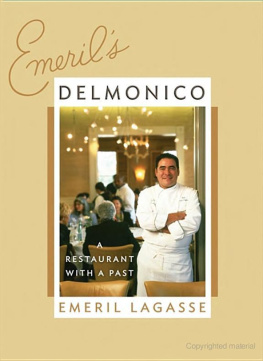Published by Louisiana State University Press
Copyright 2014 by Louisiana State University Press
All rights reserved
Manufactured in the United States of America
First printing
Designer: Laura Roubique Gleason
Typeface: Sentinel
Printer and binder: Maple Press
Library of Congress Cataloging-in-Publication Data
Fertel, Rien, 1980 author.
Imagining the Creole City : the rise of literary culture in nineteenth-century New Orleans / Rien Fertel.
pages cm
Includes bibliographical references and index.
ISBN 978-0-8071-5823-4 (cloth : alk. paper) ISBN 978-0-8071-5824-1 (pdf) ISBN 978-0-8071-5825-8 (epub) ISBN 978-0-8071-5826-5 (mobi) 1. American literatureLouisianaNew OrleansHistory and criticism. 2. Literature and societyLouisianaNew Orleans. 3. New Orleans (La.)Intellectual life. 4. New Orleans (La.)In literature. I. Title.
PS267.N49F47 2014
810.9'976335dc23
2014018055
The paper in this book meets the guidelines for permanence and durability of the Committee on Production Guidelines for Book Longevity of the Council on Library Resources.

ACKNOWLEDGMENTS
This book stems directly from my dissertation, Imagining the Creole City: White Creole Print Culture, Community, and Identity Formation in Nineteenth-Century New Orleans. In addition to overseeing research, offering ideas in conversation, challenging my scholarly interpretations, and carefully reading each and every page, a trio of professors in Tulanes Department of History each made a key contribution to the formulation and completion of this book. Knowing my interest in the nineteenth-century shifts in the meaning of the word Creole, Lawrence Powell first encouraged me to take a look at white Creole-centric manuscript collections in the Louisiana and Lower Mississippi Valley Collection at Louisiana State Universitys Hill Memorial Library. After watching me conduct archival research and read seemingly every book on the subject over a two-year span, Emily Clark told me to stop reading and start writing, some of the best advice I have ever received. And finally, Randy Sparks, my adviser and dissertation director, advised me to take as many extra writing and research assignments as I could handle. Writing outside and alongside the topic of white Creole literary culture made me a better writer.
Before my time at Tulane University, Oz Frankel and Julia Ott, members of the historical studies faculty at the New School for Social Research in New York, inspired me to take up a scholarly career in history.
Gratitude goes out to members of the Tulane history department who read various chapters and/or conversed with me on the subject of this study. Professor Jana Lipman pushed me to read deeply in the realms of fact and fiction. Thomas Adams read and offered rich commentary during the beginning stages. My graduate-school colleagues Liz Skilton and Walter Stern read various iterations of chapters and offered helpful commentary.
Russell Desmond, the proprietor of Arcadian Books in New Orleans, is a saint. He translated documents at a moments notice, read several chapters, and helped me hunt down rare Louisiana books, aiding me in my research and adding to my collection since 2007. If you, dear reader, are interested at all in French Louisiana, Desmond is an archive unto himself.
In 2009 a summer research fellowship from the office of the dean of the School of the Liberal Arts at Tulane jump-started the project by funding my long, hot summer of research in Baton Rouge. Judy Bolton, of LSUs Hill Memorial Library, helped me obtain a Special Collections fellowship that same year. Two years later, Tulanes Liberal Arts deans office (again!) and the Tulane history department paid for a research trip to Boston and Worcester, Massachusetts.
In addition to the entire Hill Memorial Library staff in 2009, I would like to thank the following librarians and archivists: Ashley Cataldo, of the American Antiquarian Society; Ann Case, of Tulanes University Archives; and Eira Tansey, Sean Benjamin, and Leon Miller, of Tulanes Louisiana Research Collection.
Among the conferences at which I have presented this work, the Toulouse conference Interculturalit: La Louisiane au carrefour des cultures, in January 2012, was especially helpful. The participants, particularly Nathalie Dessens, Jean-Pierre Le Glaunec, and Emilie Urbain, aided me in thinking about the first two chapters of this book. Greg Robinson, of the Universit du Qubec Montral, put together a fine American Historical Association panel, at which I presented parts of the first chapter.
Justin Nystrom offered helpful suggestions over lunch. David Turner helped in crafting the manuscript title. Pableaux Johnson has fed my stomach most every week over the past four years, Andre Stern has fed my mind, and Charlie Gallagher has whipped me into shape. Kira Henehan and Brett Martin graciously provided me with a place to live during the crucial last few months of writing. Susie Penman is one of the best readers and editors around, and though she came late to this manuscript, her input fills its pages. The mentorship and dinner companionship of my uncle Randy Fertel has been rewarding in ways that stretch beyond the research and writing of this book. Thanks to LSU Press, especially acquisitions editor Alisa Plant and freelance manuscript editor Joanne Allen, for aiding in the publication of my first book.
This work is dedicated to my family, especially my grandmother Ruth Fertel, all of whom encouraged my reading of both the higher and lower branches of literature.
IMAGINING
THE
CREOLE
CITY
Introduction
Creating the White Louisiana Creole
Que n crole, je veux vivre et mourir crole.
Bernard de Marigny
In the autumn of 1827, two New Orleanians waged a war of the printed word. Though both men were cultivated, politically powerful French Louisianians, Bernard de Marigny and tienne Mazureau exercised their American rights to free speech and suffrage by supporting opposing presidential candidates. Born in 1785, Bernard Xavier Philippe de Marigny de Mandeville had a lifestyle that mirrored his aristocratic French name. In 1822, as president of the state senate, Marigny, in a move on what he called one of the happiest days of my life, overturned a Louisiana Supreme Court decision to make null and void any minutes of meetings not written in English. He was thus deemed the Defender of the French language.
tienne Mazureau, conversely, was an adamant Adams man. A state attorney general for three terms and Louisiana secretary of state, in 1827 he ranked as one of the citys most accomplished and fiery lawyers and orators. Mazureau possesses a most extensive and profound knowledge of the civil law, but on certain occasions his eloquence becomes tempestuous, one historian of the period noted. He is a perfect specimen of the Southern type.
Marignys and Mazureaus opinions on French Louisianas identity deviated as fiercely as their presidential politics. In a series of late 1827 newspaper editorials and pamphlets, the pair of Francophile New Orleanians attacked each others candidates, while questioning each others allegiance to the state and the nation. Additionally, the two men published under pseudonyms befitting their places of birth. Mazureau labeled himself the Citoyen Naturalis because, though born in France in 1777, he proudly considered himself to have been a naturalized citizen of the United States for at least the past two decades.








